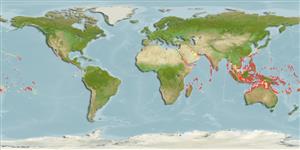Common names from other countries
>
Ovalentaria/misc (Various families in series Ovalentaria) >
Pomacentridae (Damselfishes) > Chrominae
Etymology: Chromis: Greek, chromis = a fish, perhaps a perch (Ref. 45335).
More on authors: Fowler & Bean.
Environment: milieu / climate zone / depth range / distribution range
Écologie
marin récifal; non migrateur; profondeur 3 - 40 m (Ref. 4391). Tropical; 32°N - 23°S
Indo-Pacific: Red Sea and East Africa to the Line Islands, north to southern Japan, south to New Caledonia.
Taille / Poids / Âge
Maturity: Lm ? range ? - ? cm
Max length : 13.5 cm TL mâle / non sexé; (Ref. 11441)
Description synthétique
Clés d'identification | Morphologie | Morphométrie
Épines dorsales (Total) : 12 - 13; Rayons mous dorsaux (Total) : 11 - 12; Épines anales: 2; Rayons mous anaux: 11 - 12.
Adults occur singly or in small to large aggregations in passes and steep outer reef slopes (Ref. 7247). Oviparous, distinct pairing during breeding (Ref. 205). Eggs are demersal and adhere to the substrate (Ref. 205). Males guard and aerate the eggs (Ref. 205). Diurnal species (Ref. 54980; 113699).
Life cycle and mating behavior
Maturities | Reproduction | Spawnings | Egg(s) | Fecundities | Larves
Oviparous, distinct pairing during breeding (Ref. 205). Eggs are demersal and adhere to the substrate (Ref. 205). Males guard and aerate the eggs (Ref. 205).
Allen, G.R., 1991. Damselfishes of the world. Mergus Publishers, Melle, Germany. 271 p. (Ref. 7247)
Statut dans la liste rouge de l'IUCN (Ref. 130435)
Warning: mysqli::__construct(): (HY000/1040): Too many connections in /var/www/html/includes/func_getlabel.php on line 46
Can't connect to MySQL database (fbapp). Errorcode: Too many connections
